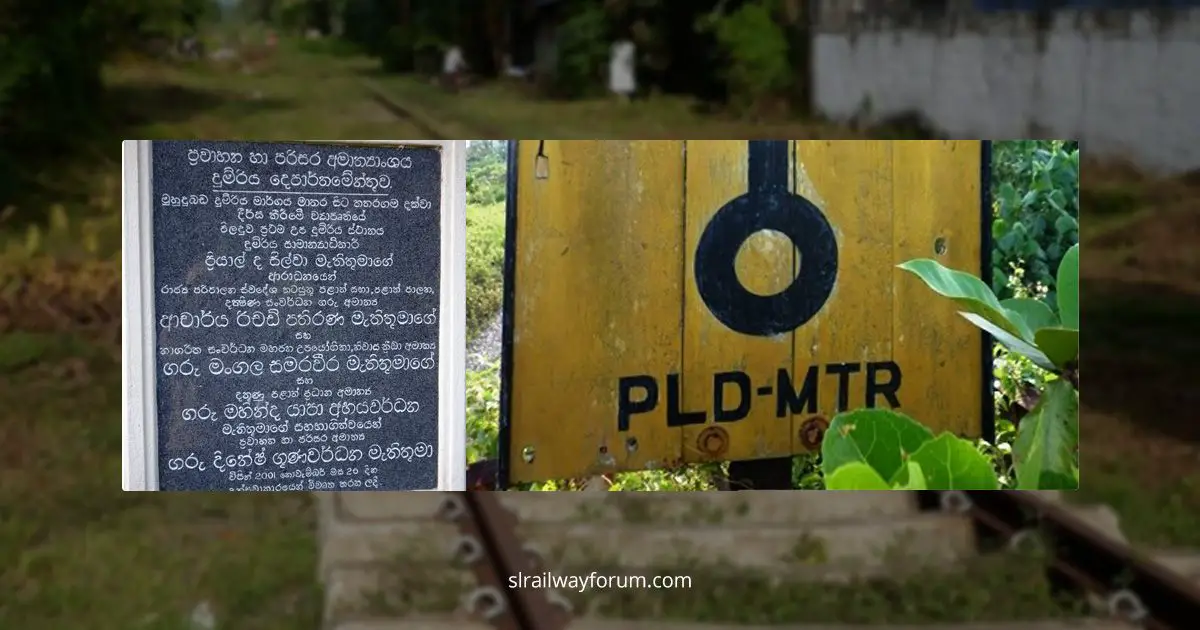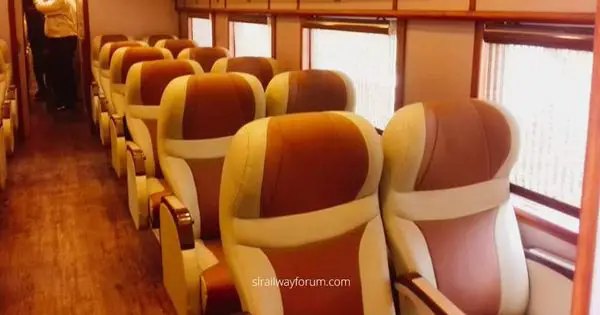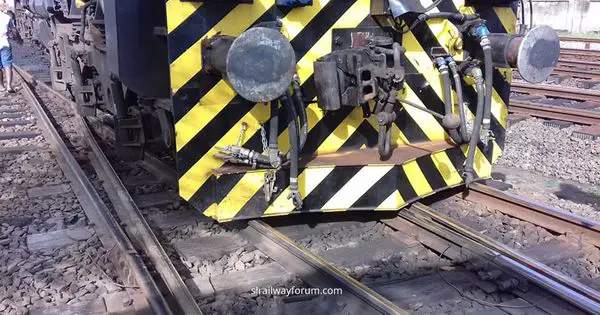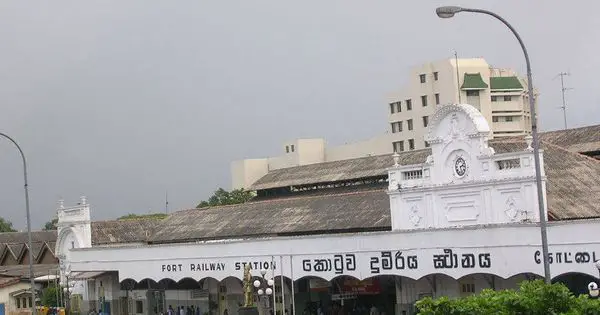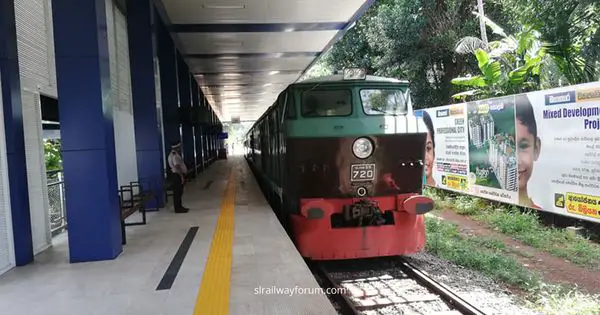The construction of the Matara-
Please note that this article was originally written 2012 by Dhanesh Wisumperuma.
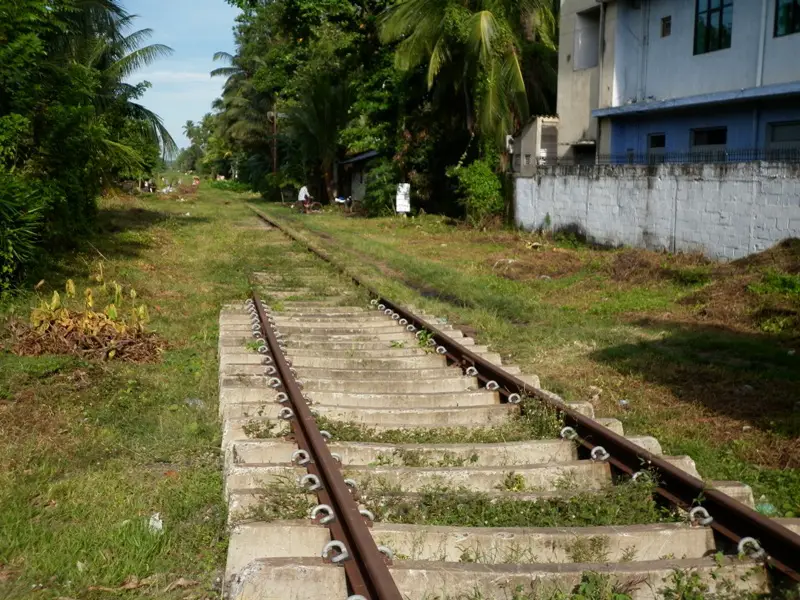
Railway line commencing near Matara Station, crossing the Thihagoda Road (in 2012)
There is no argument of the benefits and importance of this railway extension, for the present as well as future generations. If built, it will facilitate the development of Hambantota and surrounding districts. Furthermore, no major railway lines have been constructed in the country since the last major line from Polonnaruwa to Batticaloa was completed in 1928. A 14km short track from Anuradhapura to Mihintale opened in 1993. Meanwhile, over 125 kilometers of lines were closed and dismantled -the Avissavella-Yatiyantota railway line closed in 1941;Avissavella-Opanayaka track closed between1976-78; and the Udupussellawa Railway closed in 1948.
In this backdrop, looking at the story of the Matara-Hambantota-Kataragama railway extension in detail is not only a piece on the history of transport, but a glimpse of the real face of colonial administration and political motivations which have driven the recent efforts to make the dream come true.
Railway beyond Matara – Origin of the idea
According to available records, a railway extension beyond Matara has a history of more than a century. The present Coast Line from Colombo to Matara was built in phases and the last section from Galle to Matara was opened in December 1895. The idea of extending the railway line beyond Matara was first mentioned by James A. Swettenham, the Auditor General of the Colonial Government, in 1894. He observed the high population in the area beyond Matara and Dickwella and the volume of fish traffic of Gandara during a visit to Tangalle. Impressed, by these finding he proposed to extend the railway line to Gandara to pick up the fish traffic. This was about a year before the rail track reached Matara.
The idea was taken up by the government and the Assistant Government Agent of Matara, Charles M. Lushington, when the suggestion was put to them. In his report, Lushington proposed that it should be extended to Beliatta to obtain a profit from the heavy expenses of the bridge over Nilwala River and the marshy area beyond that. He opted for this route partly because of the highly rugged terrain between Matara and Gandara. He preferred Beliatta, for a variety of other reasons including the famous market at the place (in his words “the great centre to which produce of all kinds is brought from all sides”), connection between Beliatta and Dikwella by roads and traffic and the fact that Beliatta opens for a larger inland area. He also mentioned the fact it could ease a future extension of the railway line to Hambantota and pointed that the pilgrims attending the Devundara (Dondra) festival and Tissamaharama festival (Kataragama) could help justify the extension.
On the orders of the Colonial Secretary, issued in November 1894, a survey was conducted by H. Erskine of the Survey Department. Based on that, a report with estimates for the proposed line branded as ‘Gandara Railway’ was submitted by F.J. Waring, the Chief Resident Engineer of Railway Extensions in April 1895. It contained details of a short railway line of five miles and 52.7 chains long and complete and comprehensive estimates. The proposed line was to contain two stations at Dondra (Devundara) and Gandara. The estimated cost per mile was Rupees 130,811.62. The cost of earthwork was the highest of the expenses and Waring said that the proposed line between Dondara and Gandara “traverses by far the most difficult country I have yet seen anywhere so near to the coast in Ceylon”.
Such proposals were soon grabbed by the Railways. In the 1895 the map of Ceylon showing the Railways, Galle-Matara section of the line was marked ‘under construction’ and the line up to Gandara is marked as ‘surveyed’ or ‘under survey’ while Gandara to Hambantota is marked as ‘suggested for examination’.
Pressing the need of the railway
Since 1896 and up to 1921, many of the Assistant Government Agents of Hambantota as well as Matara saw the extension of the railway to Tangalla via Dickwella and Beliatta as an important undertaking. They listed it in their annual reports under the ‘works required’ and often as the ‘principal need’ or among the ‘most pressing of the requirements’ of these districts. Some of them were eagerly waiting to see the commencement of the line. Some of them were a little doubtful of the profitability factor and the seniors in government were cautious about this.
The need of the people was deemed not so important for the senior officials of the British government. The Main Line (Colombo-Badulla), which was to transport estate produce, was their main objective. The type of line that could benefit the people did not grab interest. It is evident that it was not easy for the people to a railway line from Colombo to Matara, a few decades ago, as revealed by records.
Finally a survey was sanctioned for an extension, this time from Matara to Hambantota after it grabbed the attention of Sir William Manning in the early 1920s. The survey was carried out from November 1921 to November 1922. A detailed report and estimate of the extension based on this survey was submitted by M. William Cole Bowen, Chief Construction Engineer of Railway extension in 1923. The line was now up to Hambantota, while some doubted whether it was profitable – even the Assistant Government Agent of Hambantota mentioned in 1922 that “There can be little doubt that an extension of the railway as far as Tangalla would be remunerative, but it is open to question whether the section from Tangalle to Hambantota is worth constructing at present”.
Hambantota Railway report of 1923
The 1923 survey report on the Proposed Railway Extension from Matara to Hambantota is well detailed. The total distance of the line was 49 miles and 56 chains and consisted of two parts – Matara to Polommaruwa and thence to Hambantota. The proposal was for a 5.5 feet broad gauge line and the stations were decided at a meeting held at the Matara Kachcheri in 1921. Seven stations were planned between Matara and Hambantota, i.e. Kumbalgama, Walasgala, Beliatta, Polommaruwa, Ranna, Ambalantota and Hambantota. Kumbalgama was proposed for Devundara traffic, Walasgala for Dickwella people and Polommaruwa for Tangalle. Two halting places were to be opened at Ratmale and Hungama. The Chief Construction Engineer of Railways Extension reports that, although the people want the line close to the coastal area which is much populous (Dondra and Dickwella), it is not practicable to do so because of the hilly nature of the terrain. The track was planned few miles inland through the entire route.
The estimated cost per mile was between Rupees144,648.90 and Rupees160,459.92, depending on the weight of the rail and the highest one was for the rails weighing 80 lbs. It is mentioned that the earthwork was to be heavy due to the difficulty of the country even it omitted the difficult area close to the coast. An idea could be taken of the land value in the time as it was proposed to pay Rupees 1,500 per acre for cultivated land within the ‘Four Gravets’of Matara!
The suspension of the proposal
Although the survey was complete, the main consideration of the government was covering the cost and the profitability of such an investment. Certain high rankers have already criticized this. For
The commission appointed in 1925 to look into the entire transport sector of Ceylon also referred to two railway extensions, Matara-Hambantota and Batticaloa-Nintavur. It saw no justification of the second part of Matara-Hambantota Railway (i.e. Polommaruwa to Hambantota) as the country is sparsely populated. After considering the return of the Matara-Tangalle section (1.9% profit annually of the total investment, while the other proposed line from Batticaloa-Nintavur was to operate at a loss!), it was stated, “The Commission has therefore being reluctantly forced to the conclusion that there is little or no prospect of the scheme paying for itself. The Commission is confirmed in its conviction by the opinion … that the volume of traffic likely to be conveyed by the railway will not be as great as that estimated by the Government Agent of Southern Province.” In these circumstances the Commission found itself unable to “recommend to Government the prosecution of the proposal to extend the railway from Matara to Tangalle until such time as satisfactory proof is obtainable that the project will pay for itself”. This report hints that the government was of the opinion of developing feeder roads facilitating existing railways as the then global trend was to develop motor transport!
Both the Assistant Government Agent and the head of the Railways were not in agreement with this decision of the Transport Commission. They both thought that the line to Tangalle will be as paying as the other similar existing line. A railway department map of 1928 marks the section from Matara to Tangalle as a proposed line. One mile maps of the survey department contoured and revised in early 1920s contain the Matara-Hambantota railway track in detail as a proposed line, with some of the proposed stations.
However that was to be the end for the Hambanthota Railway Line for the time being. In 1928, the then General Manager of Railways stated that with the opening of the line to Trincomalee and Batticaloa, railway extension of Ceylon has for the present come to an end. The “Railway Construction Department” was closed in 1929, after being in existence for 40 years. It was considered that there would be no further extensions of railway lines in the country. But he puts hope that it is temporary, “as other extensions to Tangalla and Kalmunai are I think justified in the immediate future with the object of pushing railhead into portions of the country which would be more rapidly developed by railway facilities”. But this immediate future was not to come during the administration of the British.
The revival of the line
Extension of railway beyond Matara took the stage again in 1970s and it was proposed to extend the line to Kataragama, but it was later abandoned. It emerged two decades later in 1991 one option was selected from the three options from Matara to Kataragama. The selected option was laid via Dickwella and Tangalla, different from the 1923 proposal – it omitted Beliatta and was to run close to the coast. There were 16 stations to be built on the 110 km long track. The first sod was cut and a foundation stone was laid by the then Minister of Transport, Wijayapala Mendis on 27th December 1991. Newspaper reports suggest of public protest against the new track, which was different from the route adopted in 1922, as people had been restrained for generations from erecting buildings on the lands allocated for that. However the work commenced, and suspended around 1995, due to lack of funds as well as the lack of ambition.
The first station (actually a substation) of the Kataragama line was built at Piladuwa, about 2 km from Matara and opened on 26th November 2001 by the Minister of Transport and Environment Dinesh Gunawardena. According to news reports a train ran from Matara to Piladuwa on the same day. But the track was yet to cross the Nilwala River.
The stalled railway extension was restarted a few years later, again by laying the foundation stone for the bridge over the Nilwala River, on 25th March 2006, by President Mahinda Rajapaksa. The track was now to go via Beliatta on a path closer to the 1923 report. It was expected to complete the line with twenty stations within a few years! However, the work didn’t continue at the pace required, for instance, the bridge was almost complete by 2008, but it seems to be in the same stage as it was then, in the accompanying pictures taken few months ago. Finance for the project is the cause of the delay, again.
At present, Hambantota District is being rapidly developed into a modern city. If we are heading for a sustainable city development there, the development of public transport should be promoted. Railway is the best option in that case, as it is beneficial in many ways – it lessens traffic, pollution and saves people’s money and state revenue. Hence the extension of the Coast Line is important. Interestingly it is also mentioned in the Mahinda Chintana (2005) under that the sustainable mobility that “provisions will be made to assign priority to public transport, and to attract passengers and goods towards larger capacity vehicles away from smaller ones, and towards rail transport rather than road based transport.”
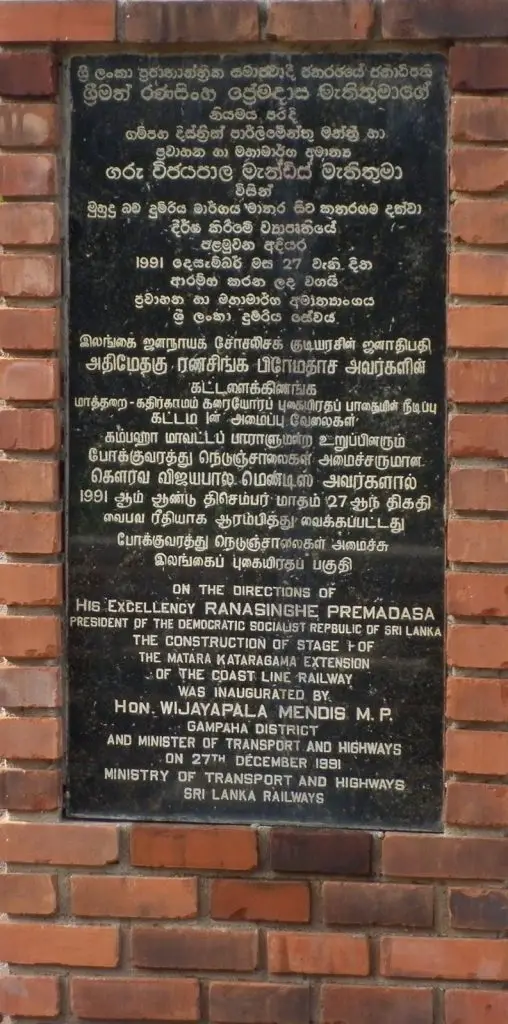
Foundation Stone of 2001
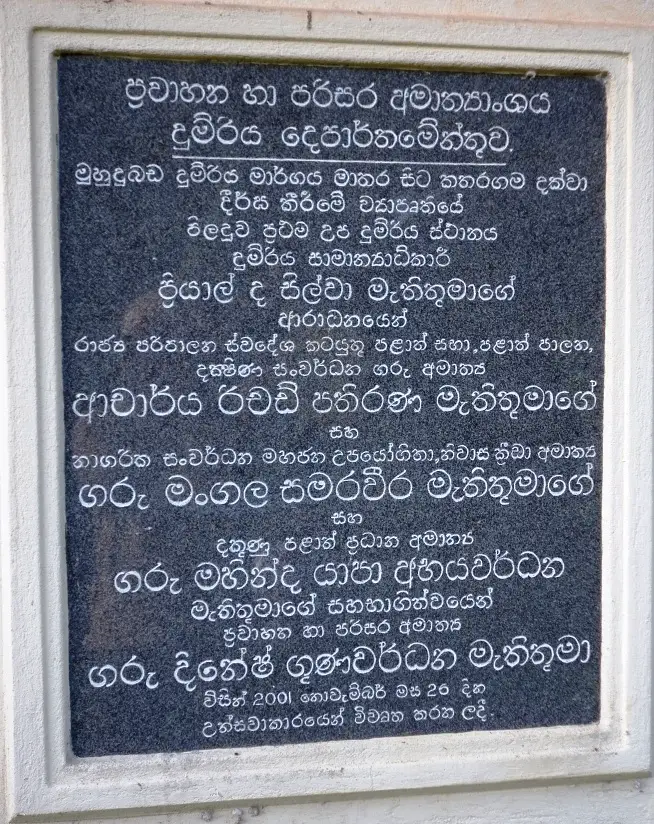
Piladuwa Sub Station, opening of 2001
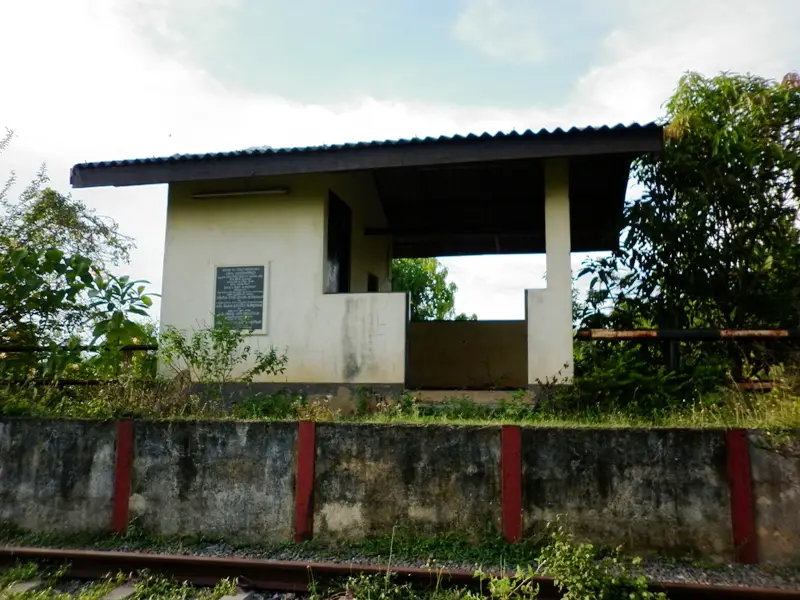
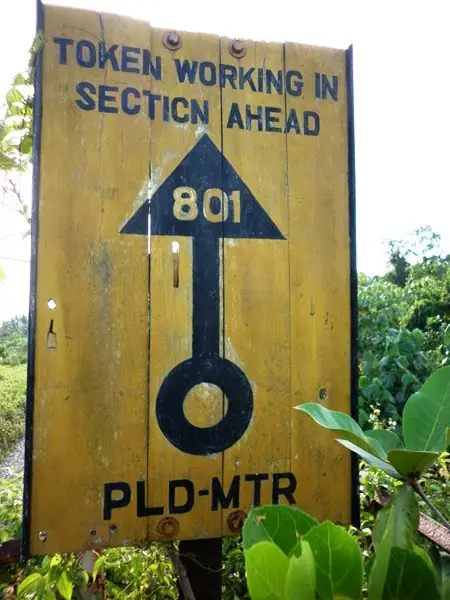

Railway bridge built in 2000s
Written by Dhanesh Wisumperuma.
Source:
http://dhaneshw.blogspot.com/2012/12/story-of-matara-hambantota-kataragama.html


